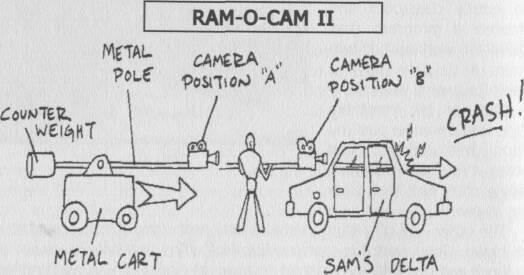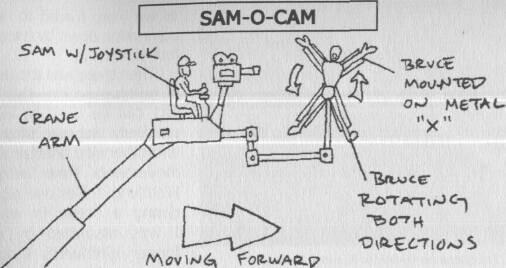Read If Chins Could Kill: Confessions of a B Movie Actor Online
Authors: Bruce Campbell
Tags: #Autobiography, #United States, #General, #Biography & Autobiography, #Biography, #Entertainment & Performing Arts - General, #Entertainment & Performing Arts, #Actors, #Performing Arts, #Entertainment & Performing Arts - Actors & Actresses, #1958-, #History & Criticism, #Film & Video, #Bruce, #Motion picture actors and actr, #Film & Video - History & Criticism, #Campbell, #Motion picture actors and actresses - United States, #Film & Video - General, #Motion picture actors and actresses
If Chins Could Kill: Confessions of a B Movie Actor (31 page)

29
BACK TO BASICS
"THE SOUTH WILL RISE AGAIN!"
I have seen how a misstep like
Crimewave
could, and has, put filmmakers on studios' "don't bother" lists. Fortunately, we had a fallback position -- doing the sequel to a successful film.
Evil Dead II
was all about licking our wounds.
Rob, Sam and I had been languishing in a slow-as-molasses financing deal, and because no green light had been granted yet, we couldn't give firm commitments to crew members, even though we had interviewed many. Then an interesting thing happened. One such woman headed south to Wilmington, where Stephen King was filming
Maximum Overdrive
for Dino De Laurentiis. For some inexplicable reason, she happened to take an audience with him and mentioned that she was interviewing for
Evil Dead II,
but we were having trouble getting the money.
With that, Stephen King called Dino, Dino called us, and we found ourselves in his gigantic office. Twenty minutes later, a deal was in place. We were urged to film as close to Dino's studio in Wilmington, North Carolina, as possible, but we were more interested in avoiding studio intervention, so we made a case for shooting in the rural town of Wadesboro. All in all, it made for a hands-free filming scenario, since executives either had to drive three hours from Wilmington, or fly to Charlotte and drive another hour and a half.
Wadesboro was the same town where Steven Spielberg shot
The Color Purple.
We considered filming on the same piece of property since the owner, Harry, had experience with film crews.
The Color Purple was what Harry's face turned when I told him how much we had to spend on locations. I explained that it was unusual for a film company to install three-phase power, central air-conditioning and nine-inch irrigation pipes to "enhance" a location, as was the case with the Spielberg film.
"He was the Cadillac of motion pictures, Mr. H," I offered, "we're just the Chevy Nova." Eventually, Harry agreed to the deal as long as we funneled additional services through him.
The crumbling local high school was our command center: sets were built in the gymnasium, dailies were screened in the auditorium and the library made a fine production office -- the school cafeteria didn't have to double for anything because we used it to cook our crew meals.
THE PAIN TRAIN
Filming in Wadesboro was a pleasant experience, with the exception of the weather. Ted Raimi would be happy to offer up a few words about temperature, both external and internal. Sam assumed that because his brother was both young and eager, he could get him to play the "heinous horror hag."
To accomplish the desired look, Ted was fitted with a foam body suit, complete with monster feet. It took a full five hours to get him ready for camera. Bear in mind, the temperature outside was at least 100 degrees, with eighty-five percent humidity. Inside the gymnasium, with poor ventilation and Tungsten lights, it hovered around 110 degrees.
The makeup effects crew carried a video camera everywhere they went and documented Ted's waking hours on and off the set. My favorite image was one of the guys pouring the sweat from Ted's monster booties into a series of Dixie cups.
At one point in the film, Ted's character had to spin in the air and cause general havoc. To do that, he was fitted for a flying harness. Depending on where they're attached to your body, these things will either dig into your groin, pinch your hips, or restrict your breathing -- Ted's harness, I suspect, did a little of all three.
On top of that, Ted had to wear those damned white contact lenses. Technology had improved greatly since 1979, but these lenses were still oversized and could not be left in indefinitely.
Ted's biggest challenge, over and above everything else, was to deliver a high-energy performance. His big scene arrived, and he was spun in the air, take after take. Crew members standing nearby were spattered with flying sweat. In the finished film, look closely as Ted spots my character and bellows fiercely -- you'll see a stream of sweat pouring out a slit in the makeup around his ear.
In-between takes, Ted was lowered to the floor and propped up on an apple box. When not gulping cups of Gatorade, an oxygen mask was clamped over his face until the next setup.
"It was worth it," Ted explained later. "It got me into the Screen Actors Guild."
Evil Dead II
required my character, Ash, to grow from "cowardly wimp" to "leader of men." This was the first time I ever had to do any kind of long-term weight training. Bulk wasn't so much the issue -- it was more about creating a sturdy physique that would work in harmony with the hero-in-a-torn-shirt concept.
To achieve that, I needed help.
Enter Mr. North Carolina -- this beefy fellow helped me set up a mini-gym in an empty classroom and created a program that called for working out two hours a day, six days a week for twelve weeks.
Sam, in his inimitable style would wander past my door, mid-workout, and holler, "You call yourself a movie star? Get that lard-ass in gear!"
The other half of getting in shape dealt with food intake -- or what
not
to intake. Gone were the morning Egg McMuffins, the banana cream pies at lunch and the buttered mashed potatoes at dinner. These were replaced with Diet Slice, fruit, fish and a protein supplement. The twelve weeks of working out during preproduction went well, but once shooting began, the two hours of working out after twelve hours of physical torment on the set became a real test of discipline.
As the program began to take hold and my system kicked into a faster metabolism, I began to shape-shift -- parts of me began to shrink, like my stomach and butt, while my chest and arms began to expand.
The interesting thing about altering the way I looked was to observe the end result on film. Because it was shot out-of-sequence, you can actually watch the
before, during
and
after
versions of myself.
SAM RAIMI STRIKES AGAIN
Sam Raimi is an exponential filmmaker -- his knowledge of film and its technique increase with each film. At the end of the grueling twelve-week shoot, Hamid, the focus-puller, remarked that he had to use every technical trick he had ever learned just for this one film. It was always amusing to catch Hamid out of the corner of my eye during a difficult shot, because he was sweating more than I was.
Sam is a technical animal -- as well as knowing lenses, he dives specifically into exposures and shutter speeds -- things that directors usually banter about in vague ways, like, "I want this film to look kinda moody." Sam would confound the camera department daily with his notions -- and subsequently the mechanical effects department, since they had to build the rigs required to get his outrageous shots.
One such contraption was the "Ram-o-Cam" -- a higher budget version of its
Evil Dead
counterpart. This consisted of a twenty-foot iron pole, attached to a rolling cart, with the camera mounted at the end of it. This device was designed to "puncture" the rear window of the "Classic," then proceed through the length of the car and burst out the front. Twenty-six takes and six windshields later, we got it in the can.
The mother of all rigs was the "Sam-o-Cam." This hellish device was a rotating, cast-iron "X" that was attached to the end of a crane arm. I was lashed to this "X" and spun around in either direction and at variable speeds. Verne, the mechanical effects coordinator, tried to make small talk as he strapped me in.
"So, Bruce, what did you have for breakfast?"
"Why do you ask?"
"Because I'll be right below you -- I want to know what's coming at me..."
Sam was at the remote controls. I was his very own "Game Boy" for an entire day -- and this was all to get
one
shot.
Another effect called for a "blood flood." To get the visual of liquid traveling horizontally at great speeds, trick photography was required. To do this, we built a portion of the set sideways. The camera was also tilted, thereby resulting in a "normal"-looking perspective. To understand this, tilt your head to the left. Now imagine that the room around you was tilted the same degree. Blood could then be poured from a rig in the ceiling and it would look horizontal.






